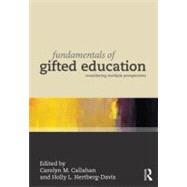
| Preface | p. xii |
| Acknowledgments | p. xv |
| List of Contributors | p. xvi |
| List of Figures | p. xxv |
| List of Tables | p. xxvii |
| Introduction | p. 1 |
| Beliefs, Philosophies, and Definitions of Giftedness | p. 11 |
| Beliefs, Philosophies, and Definitions | p. 13 |
| A Brief Synopsis of Events Influencing the Recognition and Education of Gifted Children in the United States | p. 21 |
| Policy-related Definitions of Giftedness: A Call for Change | p. 26 |
| Gifted Behaviors Versus Gifted Individuals | p. 36 |
| Being Gifted | p. 49 |
| The DMGT 2.0: From Gifted Inputs to Talented Outputs | p. 56 |
| Problematizing Gifted Education | p. 69 |
| Identification of Giftedness | p. 81 |
| Considerations for Identification of Gifted and Talented Students: An Introduction to Identification | p. 83 |
| Traditional Perspectives on Identification | p. 92 |
| The Use of Traditional Assessment Tools for Identifying Gifted Students | p. 105 |
| Identifying Gifted Students: Nontraditional Uses of Traditional Measures | p. 112 |
| Uses and Misuses of Matrices in Identifying Gifted Students: Considerations for Better Practice | p. 128 |
| Identifying Gifted Learners: Nonverbal Assessment | p. 135 |
| Not Just a Test: Utilizing Non-test Assessments in Identifying Gifted and Talented Students | p. 148 |
| Response to Intervention (RtI) Approaches to Identification Practices Within Gifted Education | p. 152 |
| Service Delivery Options and Programming Models for Gifted Students | p. 159 |
| Contexts for Instruction: An Introduction to Service Delivery Options and Programming Models in Gifted Education | p. 161 |
| Evidence Trumps Beliefs: Academic Acceleration is an Effective Intervention for High-ability Students | p. 164 |
| Cognitive and Affective Outcomes of Pull-out Programs: Knowns and Unknowns | p. 176 |
| Analyzing Pull-out Programs: A Framework for Planning | p. 188 |
| The Schoolwide Enrichment Model: A Focus on Student Creative Productivity, Strengths, and Interests | p. 199 |
| Cluster Grouping Programs and the Total School Cluster Grouping Model | p. 212 |
| The Levels of Service Model | p. 226 |
| Parents and the Development and Education of Gifted Students | p. 236 |
| Effectiveness and Implications of Homeschooling for Gifted Students | p. 248 |
| Curricular and Instructional Decisions | p. 257 |
| Defensible Curriculum for Gifted Students: An Introduction | p. 259 |
| The Multiple Menu Model: A Guide for Developing Differentiated Curriculum | p. 263 |
| Depth and Complexity | p. 277 |
| Differentiated Instruction | p. 287 |
| The CLEAR Curriculum Model | p. 301 |
| The Integrated Curriculum Model | p. 315 |
| Specific Populations | p. 327 |
| Heterogeneity Among the Gifted: Not an Oxymoron | p. 329 |
| Gifted Males: Understanding Their Challenges and Honoring Their Potential | p. 331 |
| Is This Really Still a Problem? The Special Needs of Gifted Girls and Women | p. 343 |
| Twice-exceptional Students: Gifted Students With Learning Disabilities | p. 358 |
| Gifted Students With Emotional and Behavioral Disabilities | p. 369 |
| Underachieving Gifted Students | p. 377 |
| Gifted African Americans | p. 388 |
| Asian American Gifted Students: The Model Minority or the Misunderstood Minority? | p. 401 |
| Gifted Latino Students: Overcoming Barriers and Realizing Promise | p. 412 |
| Students From Rural Environments | p. 424 |
| Evaluation and Policy in Gifted Education | p. 435 |
| Evaluating, Reflecting, Affirming, and Redirecting: An Introduction to the Evaluation of Gifted Programs | p. 437 |
| Evaluating Services Offered to Gifted and Talented Students: A Planning Guide | p. 440 |
| Assessing Resources, Activities, and Outcomes of Programs for the Gifted and Talented | p. 448 |
| Political Issues in Gifted Education | p. 458 |
| Recommended Readings by Topic | p. 470 |
| Index | p. 474 |
| Table of Contents provided by Ingram. All Rights Reserved. |
The New copy of this book will include any supplemental materials advertised. Please check the title of the book to determine if it should include any access cards, study guides, lab manuals, CDs, etc.
The Used, Rental and eBook copies of this book are not guaranteed to include any supplemental materials. Typically, only the book itself is included. This is true even if the title states it includes any access cards, study guides, lab manuals, CDs, etc.